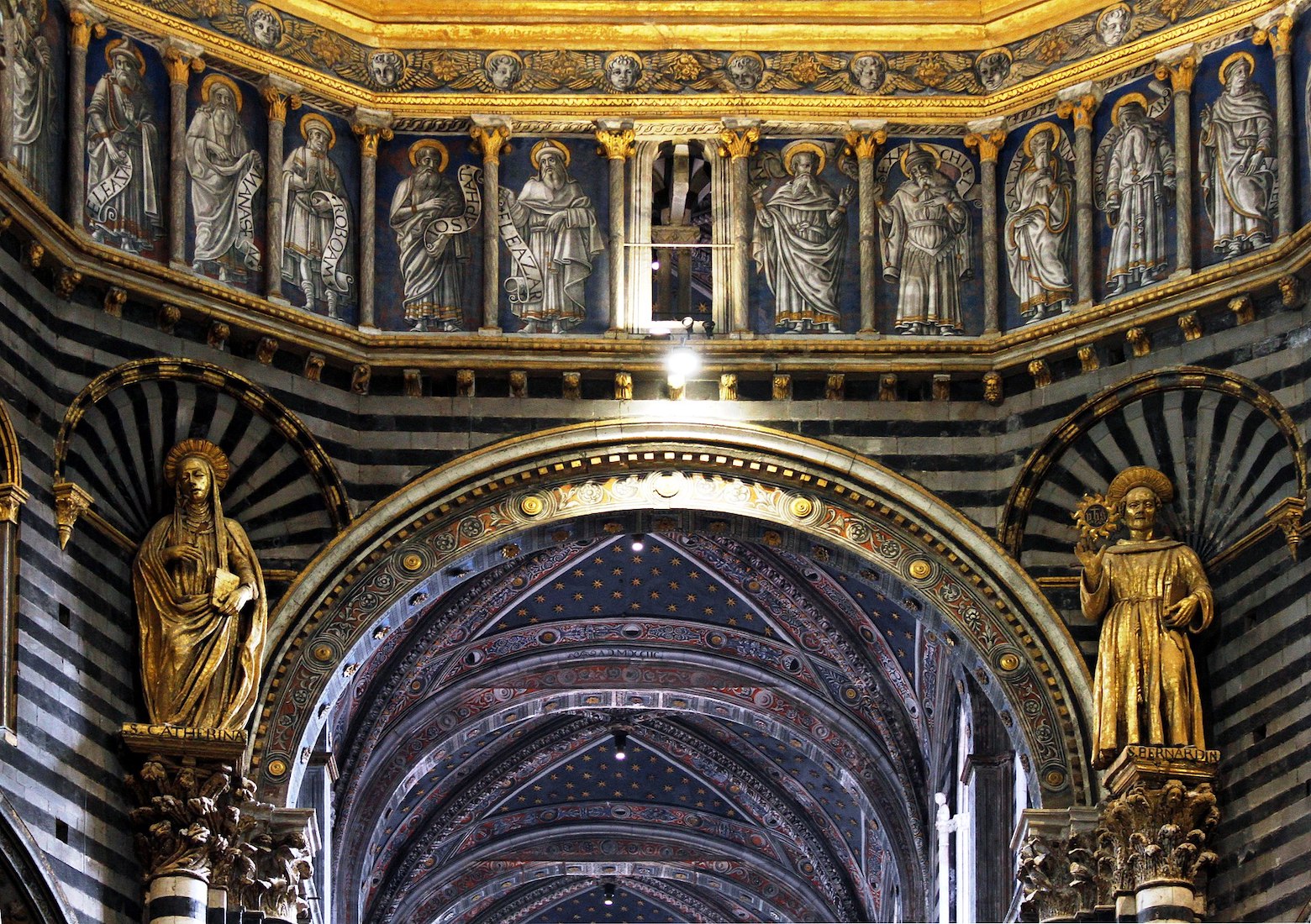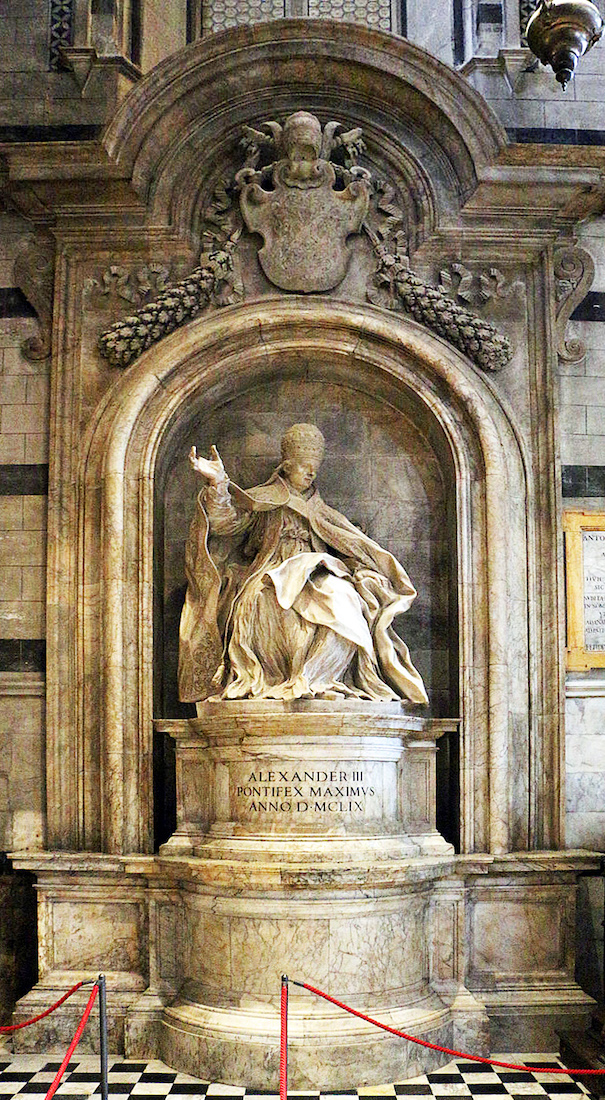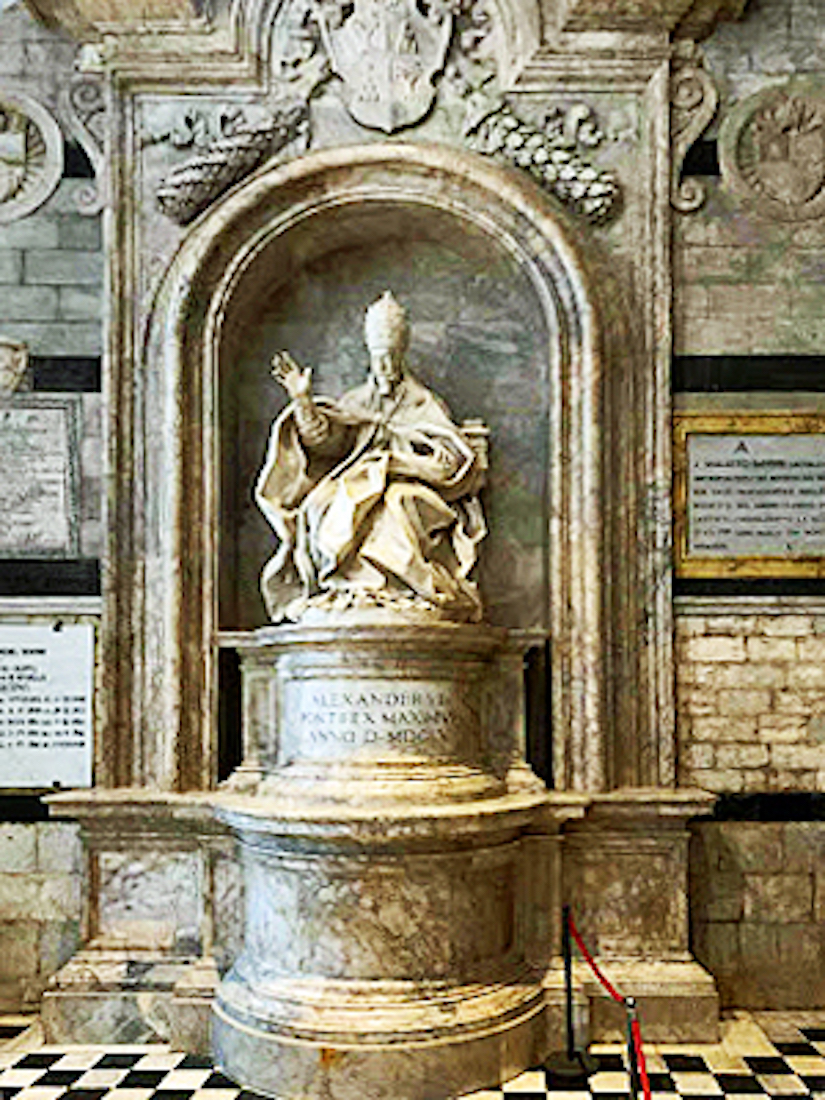
The central dome rises from a hexagonal base with supporting columns. At floor level there is a corresponding hexagonal arrangement of the floor mosaics – a central hexagon surrounded by six others, and then a further six part-hexagons to fill in the large encompassing hexagon. The scenes depicted here are taken from the time of Ahab and Elijah. [Photo Credit: Jean-Benoit Daumerie] INDEX
D2. LOOKING UPWARDS WC

As we raise our eyes upwards to the dome above, we notice the black angels on the columns. [Photo Credit: Georges Jansoone]
D3. ANGELIC CANDLE HOLDERS FB FB
There are in fact eight of these candle-holding angels attached to the central pillars, beginning at the crossing and extending towards the high altar. They are the work of Domenico di Beccafumi who died in 1551.
D4. PATRIARCHS AND PROPHETS WC ••
The colonnade in the dome is adorned with images and statues of 42 patriarchs and prophets, painted in 1481 by Guidoccio Cozzarelli and Benvenuto di Giovanni. The eight stucco statues in the spandrels beneath the dome were sculpted in 1490 by Ventura di Giuliano and Bastiano di Francesco. Originally they were polychromed, but later, in 1704, gilded. There are a set of twelve stained-glass windows in the drum of the dome, made by Ulisse de Matteis in 1886. [Photo Credits: Photo1 Superchilum]
D5. THE DOME LM
Above us is the dome – originally constructed in 1263, but has undergone several modifications since then. Although sitting on a hexagonal base, the dome develops into a 12-sided structure nearer the apex. It demonstrates a peculiar asymmetry. The dome is full of golden stars representing the kingdom of heaven. A gilded lantern at the top, added by Gian Lorenzo Bernini, gives the effect of a golden sun beaming down.
D6. PULPIT FB
As we stand in the crossing, the pulpit looms above us. Nicola Pisano created this famous pulpit between 1265-68, five years after the one he created for the Siena Baptistry. He was helped by his son Giovanni and Florentine architect Arnolfo de Cambio. This pulpit is much more ornate than the Baptistry’s, in keeping with the over-the-top Gothic style of the Cathedral. The pulpit is octagonal in shape and inspired by ancient Roman sarcophagi. It’s adorned with marble relief sculptures depicting the life of Jesus. It is supported by nine columns made of granite, porphyry, and green marble. Four of the columns rest on lions. This is Pisano’s most important work. It is significant because it marked the transition from the Gothic period to the early Renaissance.
D7. ACROSS TO THE NORTH TRANSEPT WC
As we make our way acros to the North transept, some navigational aids! The rows of seating at bottom sit upon the covered crossing mosaics. To the right we can see the immense pulpit. Directly above this is the St Ansanus altar which we will come to shortly. Across from this, in the corner, is a sculpture of one of the four popes to be found in this transept area. Left of this, and mostly obscured, are two altars along the North wall of the North transept. And at lower left is the famous floor mosaic entitled ‘The Massacre of the Innocents’. [Photo Credit: Superchilum]
D8. MASSACRE OF THE INNOCENTS WC
The Massacre of the Innocents is an episode of infanticide by the King of Judea, Herod the Great, that appears in the Gospel of Matthew 2:16-18. The author, traditionally Matthew the Evangelist, reports that Herod ordered the execution of all young male children in the village of Bethlehem, so as to avoid the loss of his throne to a newborn King of the Jews whose birth had been announced to him by the Magi. The incident is described as the fulfilment of passages in the Old Testament read as prophecies. The infants, known in the Church as the Holy Innocents, have been claimed as the first Christian martyrs. [Photo Credit: Tango7174]
D9. ALTAR OF THE HOLY CROSS GM FB
The altar at left is dedicated to the Holy Cross, the privileged altar for Requiem Masses. It is the work of an unknown artist of the mid-14th century, while the stucco relief behind it was done around the turn of the 17th century. Next to this crucifix is the painting at right. Unfortunately I have no details about this painting. [Photo1 Credit: Elena Longato]
D10. PAINTINGS OF THE SOUTH TRANSEPT ? WC
Walking directly back across (round!) the crossing, we find two more paintings on the South wall. I believe the painting at left to be ‘St Bernardine’s Homily’ by Mattia Preti. The painting at right is ‘Saint Victor taken to Martyrdom’ by Luigi Mussini We notice that it is close to a statue of Pope Alexander III. [Photo2 Credit: J Hokkanen]
D11. POPES FB GD FB GD
At the end of the 17th century, the confraternity which had charge of the altar of the Holy Cross, known as the Congregation of St Peter, commissioned statues of four Sienese Popes, two for each transept. In the South transept, West stands this statue of Pope Alexander III Bandinelli (by Melchiore Cafà and Ercole Ferrata, 1665-74), the first Sienese Pope, who reigned from 1159-81, and is traditionally said to have consecrated the cathedral on November 18, 1179. Facing it (South transept East) is this monument to Pope Alexander VII Chigi, whose family was from Siena, and who took the papal name Alexander in honor of Alexander III. This was done by Antonio Raggi from 1661-63, on a design by Gian Lorenzo Bernini; the latter was a personal friend of this Pope, and would later design his funeral monument in St Peter’s Basilica. In the North transept West is the statue of Pope Pius II (by Giuseppe Mazzuoli, 1692-5) and opposite (North transept East) Pope Pius III (by Pietro Balestra, 1703-6). [Photos2,4 Credit: Gregory Dippipo]

















